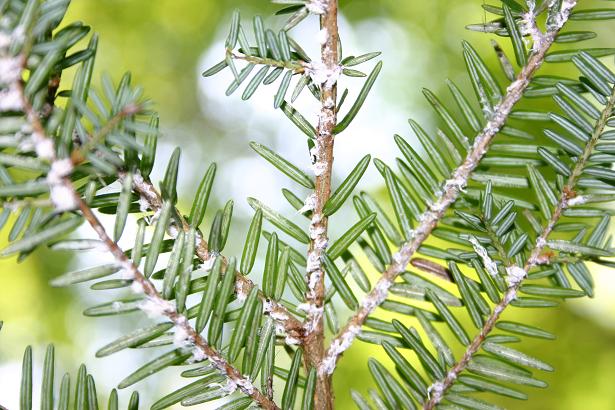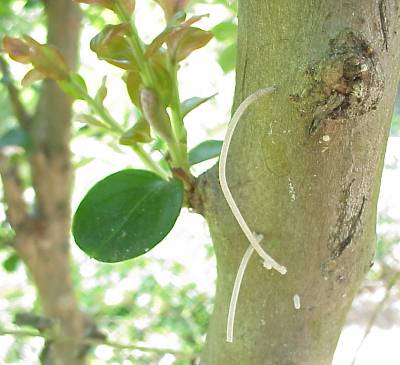Ask An Arborist: February 4, 2010
| Tree Pests: Hemlock Woolly Adelgid & Asian Ambrosia Beetle |

|

|
|
Hemlock Woolly Adelgid |
"Toothpicks" from Asian Ambrosia Beetle
(Image courtesy of Walter Reeves) |
Our native and other ornamental trees are under siege from a variety of non-native pests for which they have no defenses. Many of
you may know the fate of the American Chestnut, once the dominant forest tree east of the Mississippi...gone due to a
non-native disease. Who can forget other plagues such as Dutch Elm Disease, Gypsy Moth, Mediterranean Fruit Fly and the
Emerald Ash Borer. Two lethal pests will be on the move shortly, beginning another life cyle in early spring.
Hemlock Woolly Adelgid
The HWA is a small insect that attacks both Canadian and Carolina hemlocks. It has been found up and down the east coast from
Georgia to Canada. Pockets of infested trees have been found in town near the Governor's Mansion but the devastation that is
taking place in the north Georgia mountains is startling. A native of Asia, it has little effect on Asiatic hemlocks which
have developed resistance through eons of evolution.
With its sucking mouth parts, this bug literally sucks the life out of
hemlocks. The insects appear in the early spring as small patches of white
cotton beneath and at the base of the needles and nearby small branches.
Heavily infested trees will almost look like they have been dusted with
snow. Needles will begin to turn brown and drop followed by limb dieback.
For mature trees, death usually occurs in 3-5 years, even less on younger
trees. There are usually two generations per year. Because our native hemlocks
play a critical role in their natural habitat, more than just the trees
are being threatened.
Treatment usually involves the use of chemicals. There is no prevention. Foliar sprays of insecticidal soap or horticultural oil
are effective on smaller trees in managed landscapes that have minimal risk involved with chemical drift (creeks, rivers, etc.).
Larger trees, those in natural areas or near water sources should be treated systemically with a product that contains the
chemical imidacloprid. This is done once a year usually in the early spring. This chemical can applied as a soil drench,
soil injection or trunk injection. Applying imidacloprid directly to the soil should not be done in areas near water sources or
in soil that drains quickly. Trunk injections can only be performed by certified individuals. There is no feasible or cost
effective way to mass treat hemlocks growing in forested or inaccessible locations. As a last note, never fertilize hemlocks
infested with HWA; it only gives the bug a leg up, so to speak.
To help reduce the spread of this insect, do not transplant hemlocks from infested to non-infested areas, do not cut branches
as greenery and transport them to non-infested areas and do not harvest hemlocks as Christmas trees from infested areas.
In its native habitat, the HWA was kept in check by the presence of resistant trees and natural enemies. Research is currently
being done on the use of biological controls as a means to deal with this pest. Several species of beetle and at least one
pathogen are known to attack the HWA at various stages in the life cycle. We can only hope that something will be found
before it's too late.
For more information on the Hemlock Woolly Adelgid, visit this
web site.
Asian Ambrosia Beetle by Art Morris, Bartlett Tree Experts
Ambrosia beetles are one of the most common and most damaging insect pests of mature trees in Georgia. Aggressive Asian varieties
of ambrosia beetle were introduced to the U.S. in the mid 70ís and have spread throughout the southeast. The beetles are difficult
to identify because they measure only a few millimeters, but despite their small stature, these pests can kill even the largest
trees.
Ambrosia beetles bore tiny holes in tree trunks and buttress roots and introduce a fungus into the tree that quickly clogs the
trees vascular system, severely limiting itís ability to transport water and nutrients into the canopy. Most trees that are
attacked by ambrosia beetles begin showing signs of decline within a few weeks or months, and by the time the tree begins to
wither, it's usually too late to save it.
Beginning in March, homeowners should regularly check the bases of their trees for fine sawdust (called frass) or small holes;
these are signs of ambrosia beetle damage. In many cases, valuable trees can be treated preventively with an insect repellant
(applied to the tree trunk) to reduce the risk of an attack by ambrosia beetles. Because the tree is damaged by the fungus,
and not directly by the beetles, arborists canít be sure that systemic insecticide treatments will control ambrosia beetle damage.
As always, cultural treatments that improve tree health will help trees defend themselves from insects; these include watering
during drought, mulching the trees root system and applying fertilizer based on a soil nutrient test.
For more information on the Asian Ambrosia Beetle, visit this
web site.
If you are concerned about the trees in your landscape, you can contact a Certified Arborist or a professional tree company in
your area through the web site of the
Georgia Arborist Association.
If you have comments or questions about this article or want to submit a question that may be used in a future article, please
email me.
Unless otherwise noted, Images & Drawings Copyrighted © 2010 by Theresa Schrum - All rights reserved



